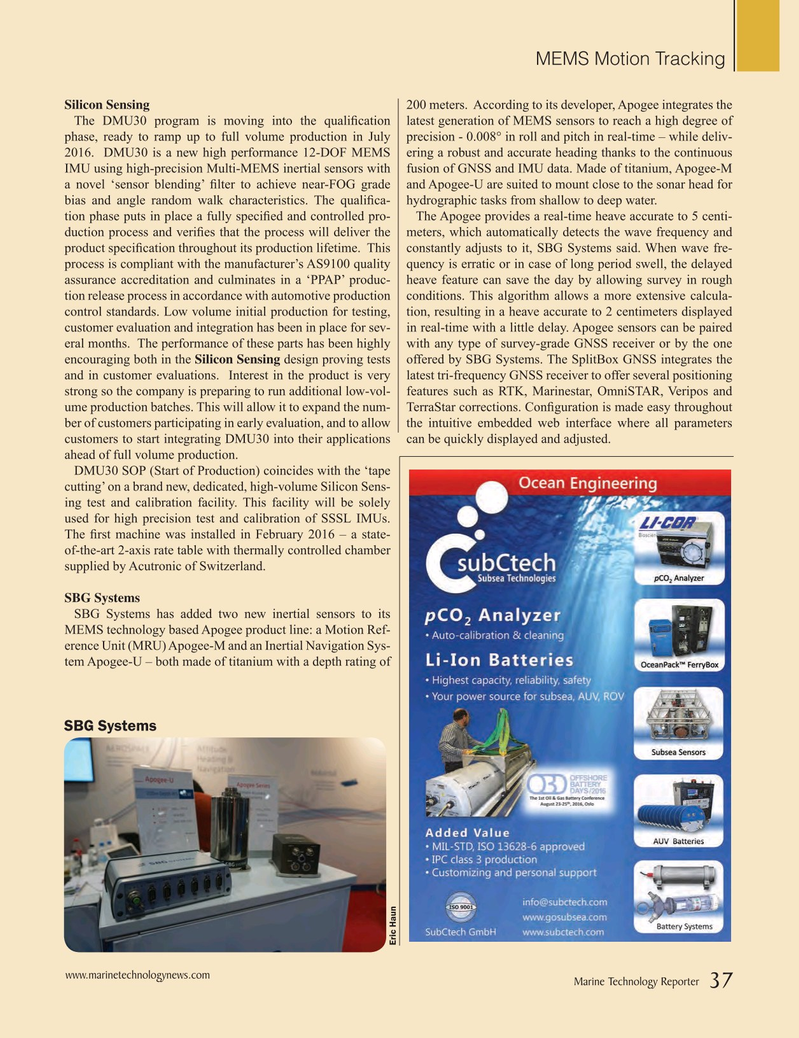
Page 37: of Marine Technology Magazine (June 2016)
Hydrographic Survey
Read this page in Pdf, Flash or Html5 edition of June 2016 Marine Technology Magazine
MEMS Motion Tracking
Silicon Sensing 200 meters. According to its developer, Apogee integrates the
The DMU30 program is moving into the quali? cation latest generation of MEMS sensors to reach a high degree of phase, ready to ramp up to full volume production in July precision - 0.008° in roll and pitch in real-time – while deliv- 2016. DMU30 is a new high performance 12-DOF MEMS ering a robust and accurate heading thanks to the continuous
IMU using high-precision Multi-MEMS inertial sensors with fusion of GNSS and IMU data. Made of titanium, Apogee-M a novel ‘sensor blending’ ? lter to achieve near-FOG grade and Apogee-U are suited to mount close to the sonar head for bias and angle random walk characteristics. The quali? ca- hydrographic tasks from shallow to deep water.
tion phase puts in place a fully speci? ed and controlled pro- The Apogee provides a real-time heave accurate to 5 centi- duction process and veri? es that the process will deliver the meters, which automatically detects the wave frequency and product speci? cation throughout its production lifetime. This constantly adjusts to it, SBG Systems said. When wave fre- process is compliant with the manufacturer’s AS9100 quality quency is erratic or in case of long period swell, the delayed assurance accreditation and culminates in a ‘PPAP’ produc- heave feature can save the day by allowing survey in rough tion release process in accordance with automotive production conditions. This algorithm allows a more extensive calcula- control standards. Low volume initial production for testing, tion, resulting in a heave accurate to 2 centimeters displayed customer evaluation and integration has been in place for sev- in real-time with a little delay. Apogee sensors can be paired eral months. The performance of these parts has been highly with any type of survey-grade GNSS receiver or by the one encouraging both in the Silicon Sensing design proving tests offered by SBG Systems. The SplitBox GNSS integrates the and in customer evaluations. Interest in the product is very latest tri-frequency GNSS receiver to offer several positioning strong so the company is preparing to run additional low-vol- features such as RTK, Marinestar, OmniSTAR, Veripos and ume production batches. This will allow it to expand the num- TerraStar corrections. Con? guration is made easy throughout ber of customers participating in early evaluation, and to allow the intuitive embedded web interface where all parameters customers to start integrating DMU30 into their applications can be quickly displayed and adjusted. ahead of full volume production.
DMU30 SOP (Start of Production) coincides with the ‘tape cutting’ on a brand new, dedicated, high-volume Silicon Sens- ing test and calibration facility. This facility will be solely used for high precision test and calibration of SSSL IMUs.
The ? rst machine was installed in February 2016 – a state- of-the-art 2-axis rate table with thermally controlled chamber supplied by Acutronic of Switzerland.
SBG Systems
SBG Systems has added two new inertial sensors to its
MEMS technology based Apogee product line: a Motion Ref- erence Unit (MRU) Apogee-M and an Inertial Navigation Sys- tem Apogee-U – both made of titanium with a depth rating of
SBG Systems
Eric Haun www.marinetechnologynews.com
Marine Technology Reporter 37
MTR #5 (34-48).indd 37 6/1/2016 5:53:03 PM

 36
36

 38
38
